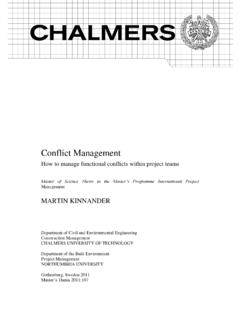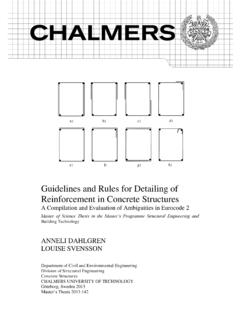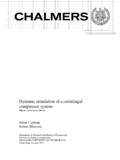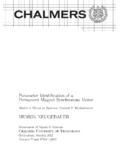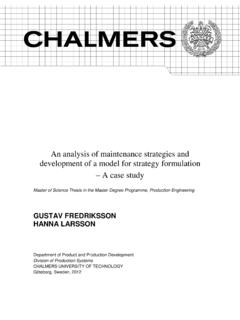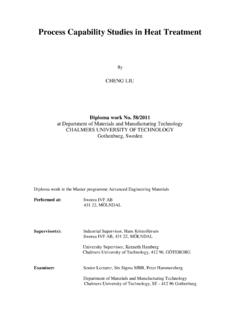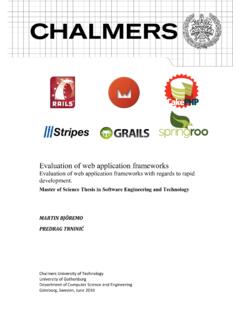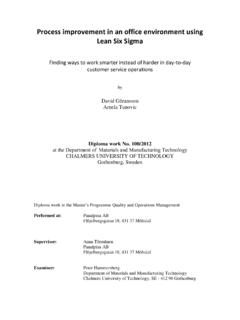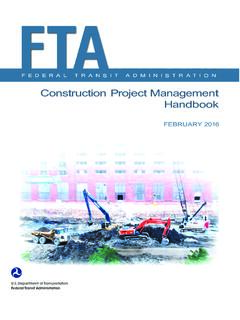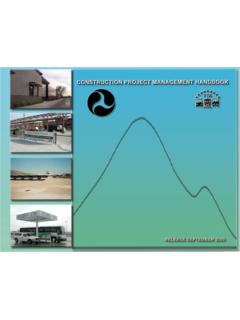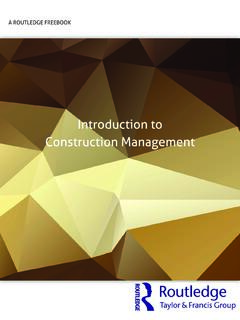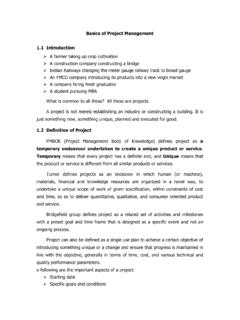Transcription of Risk Management Practices in a Construction Project a case ...
1 Risk Management Practices in a Construction Project a case study Master of Science Thesis in the Master s Programme Design and Construction Project Management EWELINA GAJEWSKA MIKAELA ROPEL Department of Civil and Environmental Engineering Division of Construction Management CHALMERS UNIVERSITY OF TECHNOLOGY G teborg, Sweden 2011 Master s Thesis 2011:47 MASTER S THESIS 2011:47 Risk Management Practices in a Construction Project a case study Master of Science Thesis in the Master s Programme EWELINA GAJEWSKA MIKAELA ROPEL Department of Civil and Environmental Engineering Division of Construction Management CHALMERS UNIVERSITY OF TECHNOLOGY G teborg, Sweden 2011 Risk Management Practices in a Construction Project a case study Master of Science Thesis in the Master s Programme EWELINA GAJEWSKA MIKAELA ROPEL EWELINA GAJEWSKA, MIKAELA ROPEL, 2011 Examensarbete / Institutionen f r bygg- och milj teknik, Chalmers tekniska h gskola 2011:47 Department of Civil and Environmental Engineering Division of Construction Management Chalmers University of Technology SE-412 96 G teborg Sweden Telephone.
2 + 46 (0)31-772 1000 Reproservice / Department of Civil and Environmental Engineering G teborg, Sweden 2011 CHALMERS, Civil and Environmental Engineering, Master s Thesis 2011:47 VI Risk Management Practices in a Construction Project a case study Master of Science Thesis in the Master s Programme EWELINA GAJEWSKA MIKAELA ROPEL Department of Civil and Environmental Engineering Division of Construction Management Chalmers University of Technology ABSTRACT Risk Management is a concept which becomes very popular in a number of businesses. Many companies often establish a risk Management procedure in their projects for improving the performance and increase the profits. Projects undertaken in the Construction sector are widely complex and have often significant budgets, and thus reducing risks associated should be a priority for each Project manager.
3 This master thesis presents an application of risk Management in the early stage of a Project life cycle of a Construction Project . In order to examine how risk and risk Management process is perceived a case study of a school Project was chosen. Moreover, based on the conducted interviews, the research presents how risks change during a Project life cycle. All analyses are based on a theoretical background regarding risk, risk Management process and Project life cycle approach in the Construction sector. Key words: Key words: Risk; Risk Management ; Risk Management process; Risk Management methods; Project life cycle CHALMERS Civil and Environmental Engineering, Master s Thesis 2011:47 VII Contents ABSTRACT VI CONTENTS VII PREFACE X 1 introduction 11 Purpose 12 Limitations 12 Outline of the thesis 12 2 THEORETICAL FRAMEWORK 13 Project life cycle 13 Pre- Project phase 15 Planning and design phase 16 Contractor selection phase 17 Project mobilization phase 17 Project operation phase 17 Project close-out and termination phase 18 Risks in the PLC 18 Project manager/ Project organization 19 Decision making process from risk Management perspective 19 The risk Management 20 Risk definition 20 A concept of risk Management 21 Benefits with risk Management 22 Limits of risk Management 23 Risks in Construction projects 23 The risk Management process 24 Risk identification 24 Assessment/analysis 26 Risk response 32 Monitoring 33 3 METHOD AND MATERIALS 35 Data collection 35 Case study and interviews 36 Limitations 36 4 RESULTS 37 Project description 37
4 CHALMERS, Civil and Environmental Engineering, Master s Thesis 2011:47 VIII The PLC 37 Risk definition 38 The RMP 39 Risk identification 40 Risk assessment 41 Risk response 42 Risks handled in the Project 44 The vision of 0 errors in the Project 44 Application of the probability and impact method 44 5 DISCUSSION 50 How are risks and risk Management perceived in a Construction Project ? 50 How is the risk Management process used in practice? 51 Identification 51 Assessment 51 Response 52 How do risks change during a Project life cycle? 53 6 CONCLUSION 54 7 REFLECTION 55 REFERENCES 56 APPENDIX A INTERVIEW QUESTIONS CHALMERS Civil and Environmental Engineering, Master s Thesis 2011:47 IX CHALMERS, Civil and Environmental Engineering, Master s Thesis 2011:47 X Preface In this thesis, risk Management have been investigated in a case study which helped to realize how the Construction industry works with this concept.
5 The research has been carried out from January 2011 to may 2011, at the Department of Civil and Environmental Engineering, Chalmers University of Technology, Sweden. The thesis has been carried out with Bygg-Fast, a consultancy company within Construction Project Management , where a school Project has been investigated in order to do this research. The research has also been supervised by Sven Gunnarsson at Chalmers University of Technology and an examination of the thesis regarding the language and formatting was made by Nancy Lea Eik-Nes. We appreciate for their help and support in this thesis. We would also want to thank all respondents in the school Project for their involvement in the interviews which we could support our research on. G teborg May 2011 Ewelina Gajewska and Mikaela Ropel 11 1 introduction Risk Management (RM) is a concept which is used in all industries, from IT related business, automobile or pharmaceutical industry, to the Construction sector.
6 Each industry has developed their own RM standards, but the general ideas of the concept usually remain the same regardless of the sector. According to the Project Management Institute (PMI) (2004), Project risk Management is one of the nine most critical parts of Project commissioning. This indicates a strong relationship between managing risks and a Project success. While RM is described as the most difficult area within Construction Management (Winch, 2002; Potts 2008) its application is promoted in all projects in order to avoid negative consequences (Potts, 2008). One concept which is widely used within the field of RM is called the risk Management process (RMP) and consists of four main steps: identification, assessment, taking action and monitoring the risks (Cooper et al., 2005). In each of these steps, there are a number of methods and techniques which facilitate handling the risks.
7 Many industries have become more proactive and aware of using analyses in projects. Likewise, RM has become a timely issue widely discussed across industries. However, with regard to the Construction industry, risk Management is not commonly used (Klemetti, 2006). More Construction companies are starting to become aware of the RMP, but are still not using models and techniques aimed for managing risks. This contradicts the fact that the industry is trying to be more cost and time efficient as well as have more control over projects. Risk is associated to any Project regardless the industry and thus RM should be of interest to any Project manager. Risks differ between projects due to the fact that every Project is unique, especially in the Construction industry (Gould and Joyce, 2002). However there are still many practitioners that have not realized the importance of including risk Management in the process of delivering the Project (Smith et al.)
8 , 2006). Even though there is an awareness of risks and their consequences, some organizations do not approach them with established RM methods. The Construction industry operates in a very uncertain environment where conditions can change due to the complexity of each Project (Sanvido et al., 1992). The aim of each organization is to be successful and RM can facilitate it. However it should be underlined that risk Management is not a tool which ensures success but rather a tool which helps to increase the probability of achieving success. Risk Management is therefore a proactive rather than a reactive concept. Many previous studies (Klemetti, 2006; Lyons and Skitmore, 2002; Zou et al. 2006) have been conducted within the field of RM but each presents a different approach to this concept. The research in this master thesis focuses on the Construction industry and how the subject is practiced in the everyday operation.
9 The concept of RM is presented in a systematized Project life cycle (PLC) approach to show differences between elements of RMP in different Project phases. The research for this study was conducted together with a consultancy company working with Construction Project Management , which consults a variety of Construction projects. This organization works with risks in a way that they are aware of risks, but do not use any specific structured methods to handle them. However, they believe that a Project s performance can be improved by implementing risk Management methods. At the time when research was conducted, the company was working on a school Project in the western part of Gothenburg, which is the case study in this thesis. The Project was chosen in order to investigate the Practices of risk Management across Project organization. 12 Purpose The purpose of this master thesis is to evaluate how the risk Management process is used in the Construction industry and how the practitioners are managing risks in everyday situations.
10 The theory of the risk Management process will be compared to the actual practice in order to investigate similarities and differences. In other words, the main idea is to see if the Construction industry is working with risk Management as it is described in the literature regarding the methods and techniques presented. In order to achieve the purpose, the following research questions have been formulated to support the investigation: How are risks and risk Management perceived in a Construction Project ? How is risk Management process used in practice? How do risks change during a Project life cycle? The objectives are to understand the concept of RM and the RMP, investigate how the sector manages risks and facilitate the use of RM focused on the Construction industry. Limitations The research focuses on the Construction industry and is based on theories of risk Management described in the literature.
